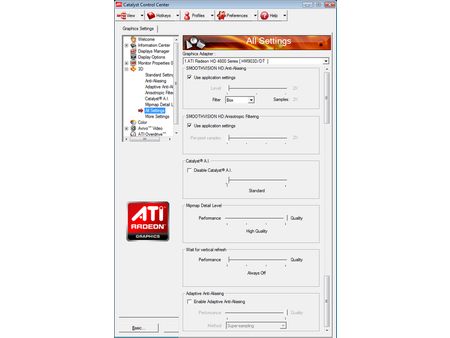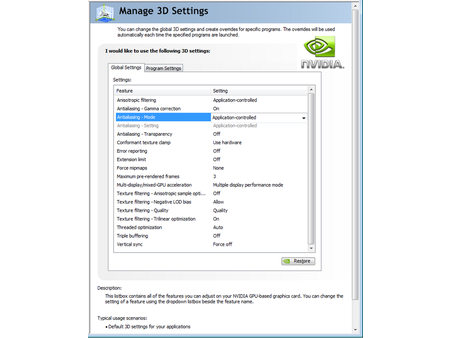VGA Charts 2008: 101 Configurations Tested
Graphics Drivers And Bugs
The graphics drivers remain in the default setting that they are in after installation. Only V-Sync is deactivated completely in order to permit the frame rates to constantly achieve their maximum possible levels during game play, independent of the graphics setting. Even with CrossFire and SLI, the settings were left as the default, which now works perfectly.
Finally, some details regarding some of the problems related to test cards and drivers.
The stock fan of the GeForce 7900 GS and 7950 GT runs quieter in SLI mode than it does when the models are working in individual mode. The X1950 XTX, X1950 XTX CrossFire and X1300 overheat passively with no additional cooling. Even the 3-way SLI configuration consisting of 8800 Ultra must be supplied with additional fresh air, otherwise the middle card of the three throttles at 103 degrees and deactivates the array. The test models from GeForce GTX 260 work well in individual mode, but when running as an SLI cluster, if one of the cards reaches 105 degrees, it throttles the GPU or crashes the PC. Manually setting the fan to 100% duty cycle did not work, as automatic driver regulation had already reached full fan revolutions. An additional 80 mm fan blowing fresh air in from the side was sufficient to solve the temperature problem here as well.
With the older graphics cards there were some resolution choices missing: the Radeon X1650 Pro, 1600 XT, 1300 XT and 1300 Pro had no 1680x1050 pixel setting, so tests had to be completed at 1600x1200. The GeForce 6600 GT, 6800 GT and 6800 Ultra had no 1920x1200 pixel resolutions, so the tests had to be completed at 1920x1080 pixels. The ForceWare driver 175.16 complained that it did not recognize the GeForce 6800 GT and 6800 Ultra, so the necessary files were linked manually via the Device Manager.
Be careful when you look at our results for some of AMD’s boards. Graphics cards of the X1000 series can only handle Shader Version 3, and because they are only able to run DX10 games in a DirectX 9 mode, they are faster than the HD 2000 series, which must draw the more intricate DX10 effects. The same applies to the Radeon X800, which only supports Shader Model 2 and does not need to calculate the more complex Shader Model 3 effects. The older AMD cards cannot handle soft particles in Quake Wars, and as a result, achieve higher results than the new graphics models.
Frame rates of less than 1 fps are rounded up to 1, while resolutions that were not tested due to crashes or lack of support were assigned 0 as a test result.
Get Tom's Hardware's best news and in-depth reviews, straight to your inbox.
Current page: Graphics Drivers And Bugs
Prev Page Graphics Settings For Each Of Our Tests Next Page Results-
rocky1234 Not to nit pick but ummm where is the Radeon 4870x2 2GB card in those charts or did I miss it you know the one with 2GB memory umm 800x2 shaders GDDR5 memory 3.6Ghz rated at & 750 core x2 whatever.Reply -
Mathos Just curious. Why is it you're using catalyst 8.6 for the ATI cards which doesn't have proper support for the 4000 series cards, instead of 8.7 or 8.8? Yet for the Nvidia cards, you use the most up to date drivers.Reply -
cangelini Rocky1234Not to nit pick but ummm where is the Radeon 4870x2 2GB card in those charts or did I miss it you know the one with 2GB memory umm 800x2 shaders GDDR5 memory 3.6Ghz rated at & 750 core x2 whatever.Reply
As mentioned in the charts introduction, these numbers take hours upon hours to compile, which means setting cut-offs for the product submissions and drivers. Unfortunately, the X2 didn't make it. However, there are results for a pair of 4870s in CrossFire, which is a roughly equivalent configuration. You'll also notice that there are no 4600-series Radeons. Again, same issue. -
ossie Why do I have the impression that at THG is a persistent confusion between power and energy?Reply -
JeanLuc Great job, I'm always pointing people to the charts now they can compare the latest hardware.Reply
The charts also show the difference between games they are coded well and ones that aren't. Compare Crysis (very high quality) and HL2 Ep2 at 1920 x 1200 4xAA 8xAF, on Crysis even the best hardware left begging for mercy at around 24fps, yet HL2 EP2 which looks just as good (graphically speaking) IMO will run at 30 FPS on a 8600 GTS (yes an 8600 GTS!) and X1800XL. A small portion of the difference can be put down to DX10 but not all of it. -
Wonder why you insist on using catalyst 8.6 - a 3/4 months old driver, out *before* the whole HD4xx0 series and not really supporting it. And by the time the 48x0 cards were released you also had a better driver with actual support the the cards (and some 10% performance boost).Reply
-
buzzlightbeer OMFG they did it again, why oh why did they use 8.6 drivers didnt they learn from all the annoyed people from the last testReply

